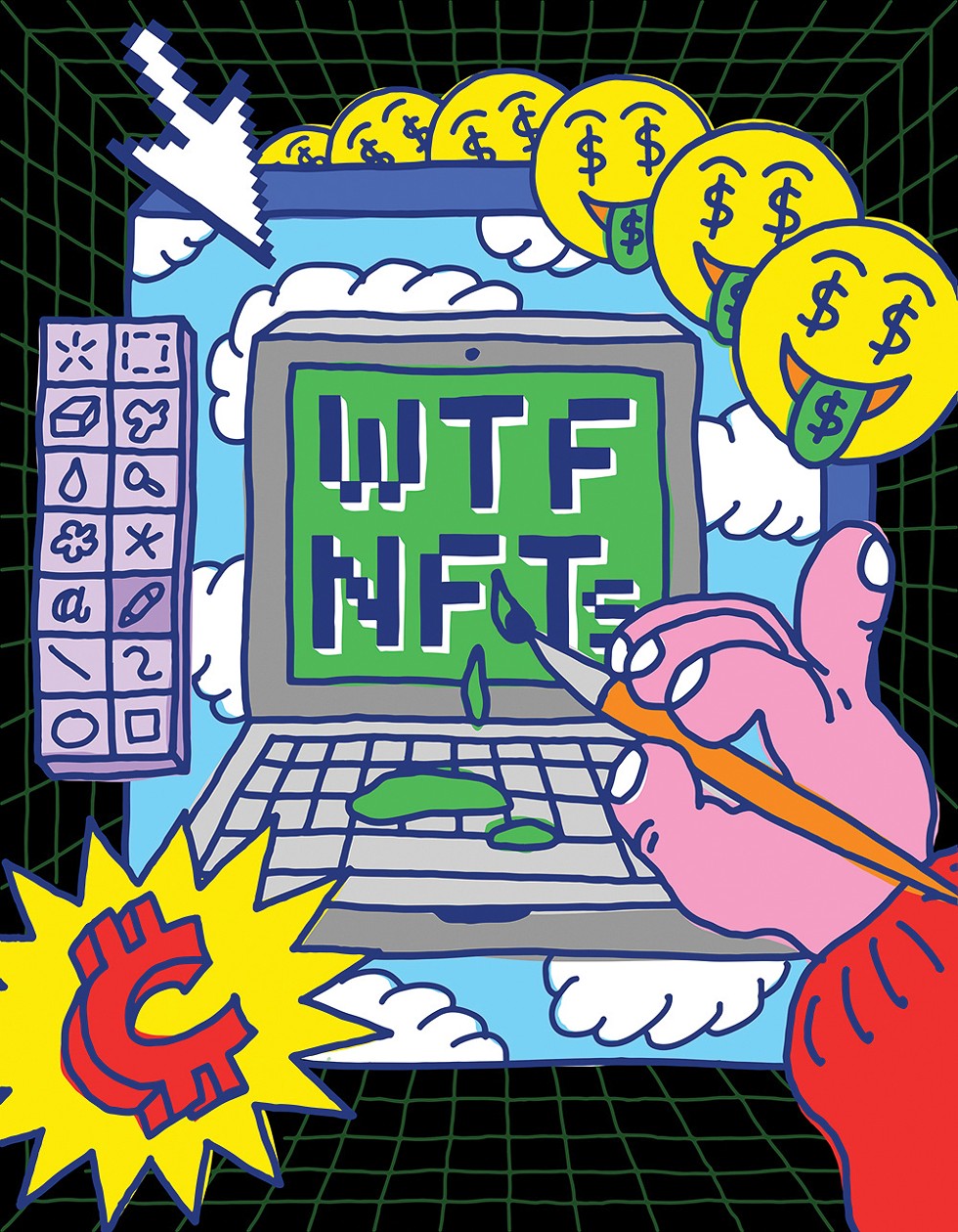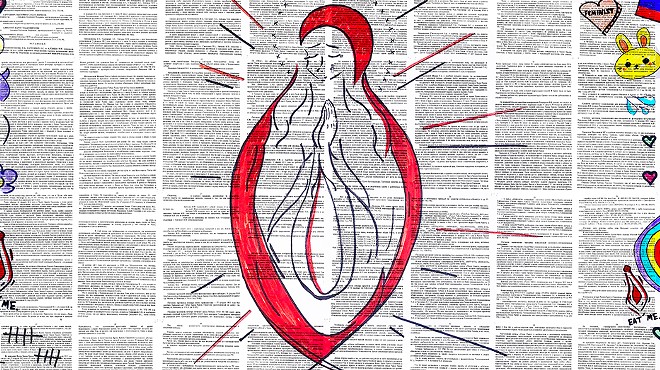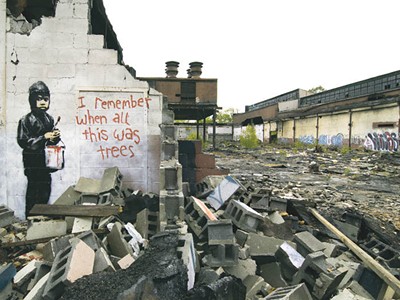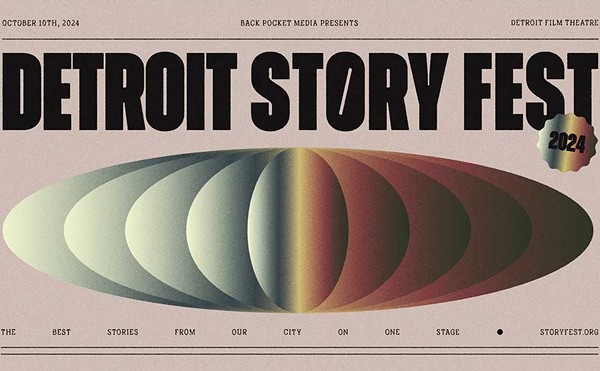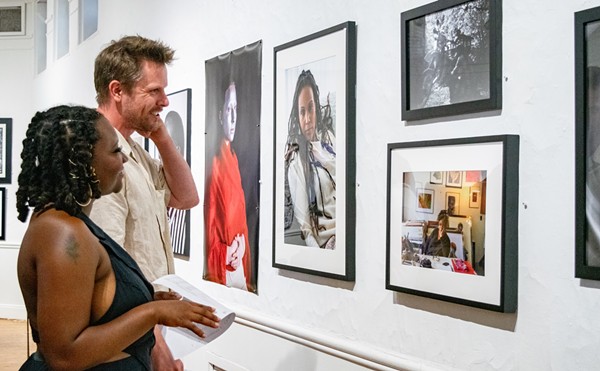When prolific Detroit artist Sheefy McFly posted his series of NFTs for sale on OpenSea in December, it sold out in a matter of minutes. The five limited-edition digital drawings were really just characters from Super Mario Bros, The Simpsons, and Dragon Ball Z mashed together like a Frankenstein experiment, but they each sold for 0.69 ethereum, or about $300 at the time.
Unless you're someone who's already hip to the world of NFTs and cryptocurrency, the paragraph above probably doesn't make much sense to you. First of all, what the hell is an NFT and how do you buy one? What's OpenSea? What is cryptocurrency? Even after speaking with several Detroit-based artists and organizations working in the NFT space (which may as well be outer space), the concept can still be a bit elusive — everyone seems to have their own ideas of what this new technology is and what it can do. Let's try our best to break it down.
"NFT" is short for non-fungible token, a unique digital file stored on a blockchain, or a decentralized, peer-to-peer network of computers. Ethereum is a form of cryptocurrency, or a digital currency also stored on a blockchain. (In 2009, the first cryptocurrency, Bitcoin, was created, with the idea of developing a digital currency without the need for a central bank.) Unlike cryptocurrency, or money in general, NFTs are not mutually interchangeable (hence "non-fungible"). While they often take the form of digital art or music, an NFT can really be anything from the deed to a house to an eternal loop of cat videos. For the sake of this article, we're going to be focusing on NFTs being sold by artists. OpenSea is just a platform where artists sell NFTs — think like eBay or Etsy.
When you buy an NFT, you're also purchasing an encryption code that serves as a sort of certificate of authenticity on the blockchain. It shows who created the NFT, who has owned the NFT, and who currently owns the NFT.
"You can never not be the original artist once you're on the blockchain," says Doyle Huge, the artist behind Detroit's iconic cockroach-shaped art car, dubbed "the CarCroach."
Crypto nerds get super into this stuff, and some believe NFTs give artists more autonomy since they could share their work without paying submission fees to get into an exhibition, for example, or giving galleries a huge cut of the profit when a piece sells.
You can even build all types of things into the file's encryption code, including royalties from future sales.
"A lot of times if I do an exhibition, the gallery takes 30-50%," McFly says. "If I sell a physical painting and someone resells it, I don't get a cut. With my NFTs, I can get a 10% cut every time someone resells that piece, and it has happened. I'm drawing it on my iPad and putting up a jpeg, and I can make just as much if not more than a mural or painting."
A common criticism of NFTs, however, is that they're basically just expensive jpegs that anybody could take a screenshot of instead of buying. (At least with a one-of-a-kind painting, for example, you could hang it on your wall.) Plus, the values of cryptocurrencies are constantly fluctuating; at the time of writing, 1 ethereum, or 1 ETH, is worth roughly $2,500. That's not to mention that cryptocurrency can be a difficult concept to grasp for many people.
"I'm not trying to dilute the importance of NFTs, but it's basically free money for a jpeg," McFly says. "But at the end of the day, it's not really about the jpeg. It's about the encryption code. If I have a Bentley and somebody takes a picture of it, that doesn't mean they own it, because I have the key. The encryption code is the key."
NFTs have also become sort of a joke in some circles because they often stretch the concept of what can be considered "art" to an almost unrecognizable degree. A lot of times, the digital art that is sold as an NFT doesn't have as much painstaking detail as, say, an actual painting would, either.
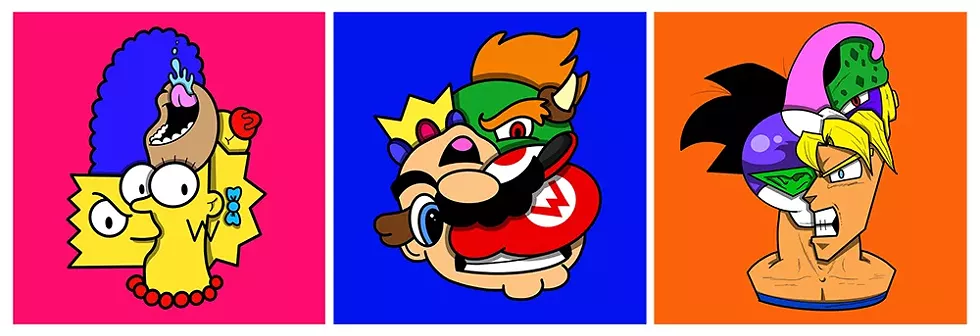
Jack Dorsey, the CEO and founder of Twitter sold his first tweet as an NFT for over $2.9 million. Yes, it's literally his 2006 tweet that says "just setting up my twttr." Then you have burger chain White Castle, which released an NFT collection called Sliderverse with digital artist Che-Yu Wu. The animated images feature highly-pixelated White Castle menu items like sliders, chicken rings, and fries that look like they were plucked right out of an old-school arcade game like Galaga.
The Bored Ape Yacht Club collection is probably the most popular, but still unimpressive, example of NFT art. They're ape avatars that look as bored with themselves as I am, but for some reason, celebrities are going apeshit over them.
Eminem bought a yawning BAYC wearing a trucker hat and a gold chain for 123.45 ETH (around $461,868 at the time). He's joined by other bandwagon-jumping celebrities like Jimmy Fallon and Paris Hilton, who've dropped hundreds of thousands on these things. (On a recent episode of The Tonight Show, Fallon and Hilton already sounded bored of their Bored Apes.) At its worst, NFTs can feel like the latest hollow trend, but the creators behind the BAYC are probably laughing their asses off all the way to the bank as the hype continues to grow.
I write about art all the time and understand that it is subjective. Art is for the satisfaction of the artist, and whatever it is that they want to express through their work. The audience is merely an observer who is receiving the artists' message, and whether you like it, understand it, or think it outright sucks doesn't really matter.
"When a new art style emerges, there's always gonna be confusion, irritation, and misunderstanding," McFly says. "Think about it. People hated Warhol's work when he first started. People just don't get it yet, so they're going to hate on it right now, but with how everything is going with NFTs and the Metaverse, this is something that can't be overlooked," he says, referring to a virtual reality space that Silicon Valley players like the company formerly known as Facebook say is the future.
He adds, "You can't just say this isn't art and shun it away."
But what makes someone want to spend $400,000 on a cartoon drawing that looks like it probably took a high school student an hour to make? Or $2.9 million on a tweet? I don't have the answer to those questions, because that just seems like a rich person playing off mass psychosis to get richer by doing absolutely nothing.
In Detroit, however, NFTs present a way for artists to truly take their creativity to previously unimaginable realms. They're just another means for fans to support artists that they know and love, sometimes with added benefits beyond just a digital drawing.
"The fact that people can support an artist just by simply buying a jpeg is the part that those haters are ignoring," Huge says. "Are NFTs like Beanie Babies? Maybe. Anything that gets really hyped is going to have that. Once it goes up, it comes down. Sure, maybe there's 1% of NFTs that are making $1,000 every week, but look at people who are buying them to support artists."
Huge has sold a few NFTs of his own, including digital 3D scans of his art car, the CarCroach, a 2004 Civic Honda with hunks of metal and junk welded to it to make it look like a giant cockroach. (You've probably seen it puttering around Detroit at the Marche du Nain Rouge parade and wondered WTF it is.) Huge says the NFTs are more than just the image, though, and that ownership of the digital file could come with other perks.
"[The CarCroach NFTs] look kind of rough and tumble and as lo-fi as the art car, so we thought if people are going to invest in these NFTs, maybe they get an experience with the Roach," he says. "Maybe we'll show up to your wedding with it or take you to your bar mitzvah, or do whatever you want."
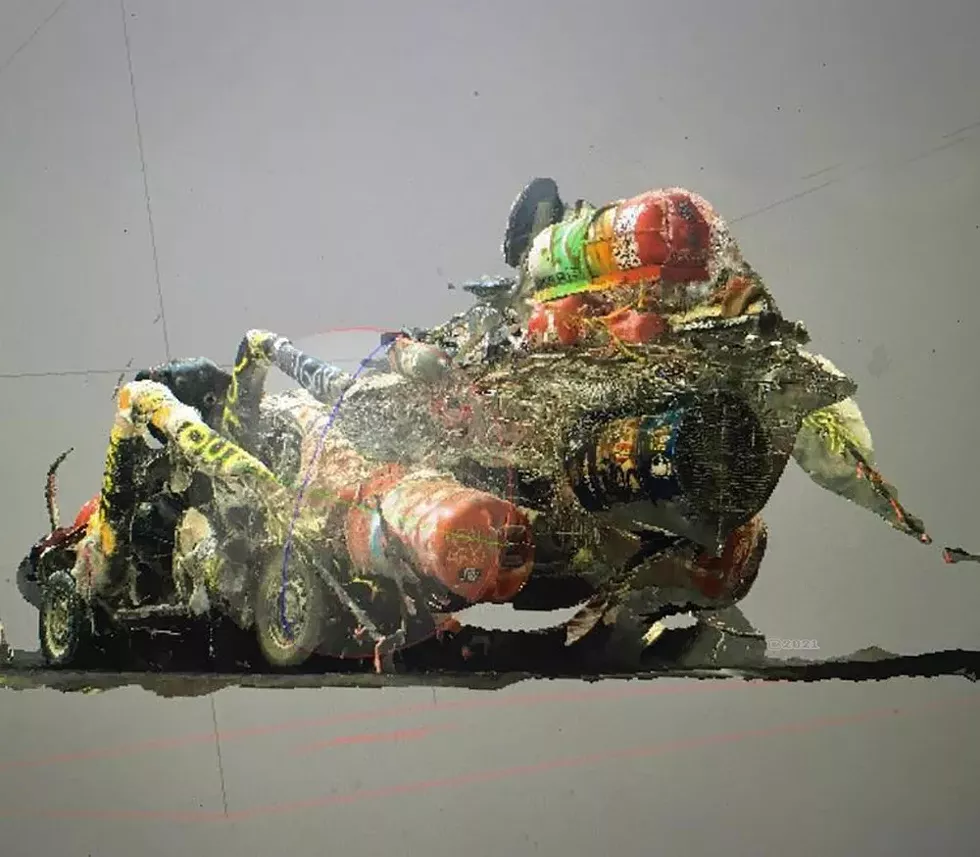
'Everywhere and Nowhere'
Similar to Huge, Gerald Collins sees NFTs as a new medium to play around with. The Detroit-based artist released a collection of three NFTs in a partnership with art gallery Playground Detroit called "Everywhere and Nowhere" late last year.
"I look at the artistic mediums as channels, and whatever you go through shapes the end experience for the viewer," he says. "It really doesn't matter which medium I choose, it matters what the purpose of the actual project is."
"Everywhere and Nowhere" combines elements of light, sound, and film. Raging waterfalls crash over rocks and peaceful streams flow gently in a glowing circle as ethereal music plays in the background. That's a very poetic characterization of the collection, which could also just as easily be described as a one-minute video loop of footage of water with a fluorescent filter and music layered on top.
"What I really want people to focus on is the water patterns within the circles and the light that surrounds them," Collins says. "The light is there to challenge the perception of what colors people see because light hitting the water changes what the eyes perceive. It's actually part of a physical installation that I designed and took footage of, and the water is footage from my travels, so there's a mix of physical and digital mixing."
The collection has five copies of each piece available for sale at 1 ETH each. (To refresh your memory, 1 ETH was around $2,500 at the time of writing.) You can easily view the short video-format NFTs on Playground Detroit's Rarible page, which is another platform to buy and sell NFTs similar to OpenSea. Of course, this will undoubtedly cause nagging naysayers to, once again, question why someone would pay that much for something they can easily view for free.
But really, it's the same as collecting anything else, whether it be baseball cards or vinyl records. Yes, these are mass-produced items, but there are people out there who are willing to drop a couple hundred or even a thousand on a particular record just because they love the artist and want to have bragging rights about their collection. NFTs are the same.
"If you collect books, or albums, or figurines, what's the difference?" Collins says. "People scan books and you can see them online, but it's a different feeling actually owning that book. At the end of the day, the NFT is still art and it's still coming from that artist's lexicon of work."
Every purchase of an "Everywhere and Nowhere" NFT also comes with a still shot of the piece printed on plexiglass. This extra feature is part of what's built into the NFTs encryption code. These codes give artists limitless possibilities for what they can include in an NFT, whether it's royalties, music, or a physical copy in addition to the digital version.
"Something additional that's physical will stand the test of time, because we don't know how the NFT space will look in the future," Collins explains. "Music artists have built in one-on-one sessions with themselves for 'x' amount of minutes in NFTs, for example. These are all added incentives for any collector."
Collins also points out how NFTs became a way for people to view and collect art early in the pandemic, when many museums and galleries were closed.
Then there's Hygienic Dress League
Hygienic Dress League is and has always been weird as hell. The Detroit-based hipster art duo Dorota and Steve Coy (who are also husband and wife) became a legally registered corporation back in 2007 as part of a performance art piece. Now they plan on making shares of their company available for public purchase as NFTs.
"A corporation is a human-made thing. Why is that a thing that exists in our society?" Steve says. "Why is our value structure based around profit? Society could be structured in any way we want it to. Corporations could be families and profits could be spending time together."
In early January, Hygienic Dress League applied for certification through the U.S. Securities and Exchange Commission (SEC) to be able to legally sell their company stock.
By purchasing 10 shares in the company, which start at $50 each, a buyer will receive an "employee" — a digital character that is also an NFT. There are three tiers of employees available: the "Extractors," which are the most common, "Transporters," which are mid-level, and "Executives," who are the top dogs.
There are 44,444 Extractors available, while Executives are rarer, with only 2,222 available. The catch is that a shareholder has no idea which type of employee they will get, as it's completely randomized. You can also get "promoted" by exchanging employee types. For example, if you collect five Extractors, you can become a Transporter. Four Transporters can be promoted to an Executive.
The three-tiered employee system is an obvious social commentary on the working class being disposable, while CEOs make more money and exploit the people that work below them.
"[Extractors] do all the work. They show up and they do what they're told and they get shit pay," Dorota explains. "Extractors are the backbone of our society. The way things are structured now puts these people at a disadvantage."
So shares from Hygienic Dress League Corp., which is really just a symbolic venture and satirization of corporate culture, can be purchased as NFTs. Then, after buying 10 shares, investors will receive an NFT of one of Hygienic Dress League's employees, which effectively makes them an employee. A limited number of employee NFTs might also be released for purchase without leading their owner to becoming a shareholder in the company as well. Lost yet?
It's such an abstract idea that it leaves us with more questions than answers. And still, there's more layers to the experiment underneath the folds.
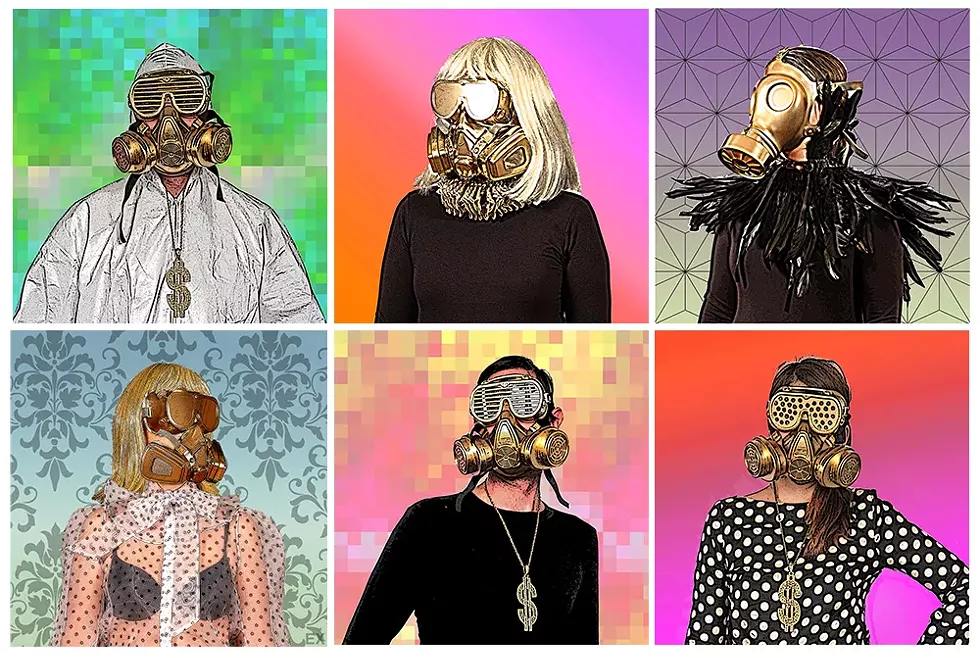
Possessing an NFT from HDL Corp. comes with some extra benefits, too. Anyone who holds a stock NFT or an employee NFT will get access to a virtual office. What's a virtual office, you ask?
"The virtual office will be a place for avatars to gather and experience surreal installations," the company's manifesto states. "An exclusive virtual market place for additional NFTs will also be available in the virtual space... HDL Corp. will build an augmented reality experience for shareholders and employees."
No, this augmented reality doesn't actually exist anywhere in the metaverse just yet — it's still just an idea HDL is playing around with. Eventually, they plan to open art spaces (real, physical ones) around the U.S. featuring installations, a drink lounge, and NFT galleries, although you'll have to be an HDL Corp. employee or shareholder to get in.
A promotional video for Hygienic Dress League's NFT release features golden gas mask-clad workers wearing hazmat suits and goggles, bowing in a circle as a gold triangle descends from the sky. Elsewhere, more gas mask-wearing figures (this time, much better dressed) stand in front of an abandoned house as they show off a golden pigeon spinning around in their hands.
Hygienic Dress League obviously has a thing for painting things gold, and the gold gask mask motif makes an appearance in almost all of their other work. Even though the video is clearly satirical, it straight up looks like it could be a ripoff of a Lady Gaga music video. But maybe that's kind of the point.
"Our visuals seem like there's a lot of sarcasm and humor, and people wonder is this real or is this fake," Steve says. "It's humorous, but there can also be these sad undertones when you think of things on a deeper level. It's meant to be playful and fun, but also thought-provoking."
They want people to question why they go to work and what they actually want to do with their lives.
"We're all going through this thing called life and we're just sort of programmed to do it. You get married, you work a job to make money," Dorota explains. "A lot of our food grows on trees for free, yet we pay for it. We work a whole bunch to pay for free time."
While they aren't wrong, and maybe these are things we should think about, everyone doesn't have the luxury of quitting their jobs to make art. People living in poverty with families to feed, crippling debts to pay, or who are otherwise just surviving (hello!) cannot commit themselves to such an experimental idea. To HDL's credit, when challenged on this, they don't deny it.
"We know that we do come from massive privilege to be able to do this project," Dorota says. "You are trapped. Society is structured against the have-nots. That is actually the point, that people don't actually have time to question these things. We're not saying to individuals, 'Hey, quit your jobs and become artists.' Steve and I are full participants in the world we live in. We just formed a corporation to become players in it. We took art and corporatized it."
How about something a little less confusing?
There are some people out there who are trying to demystify NFTs and make them more accessible to the average person. FACINGS is a Detroit-based NFT infrastructure platform that allows brands and artists to sell NFTs. The company currently hosts NFTs on the WAX blockchain, which costs artists less money to upload their artwork than other popular blockchains. Most importantly, with FACINGS, you can buy an NFT with either cryptocurrency or a credit card.
"If someone is new [to NFTs] and they don't have whatever amount of money needed to get their first NFT, we're like yeah, you can just buy one using a credit card," says FACINGS Media Producer and IP Analyst Francis Kräbbe. "We spent a lot of time and energy and testing to make sure [crypto] wasn't a barrier to entry accessibility... because the amount of information and misinformation about it is overwhelming. In order to cut through that, we wanted to offer the experience of being able to just spend 10 or 20 bucks to check it out."
Finally, NFTs for the rest of us, who do want to support artists but can't wrap our heads around the whole crypto thing. You can also sign up for a WAX wallet with platforms like Google, Facebook, or Steam.
FACINGS is officially launching its NFT platform later this year, but they have already worked with several artists to sell their collections. These include a range of NFT packs from a comic book with collectible pages to tickets to see an online concert at Dectraland (a virtual world platform that's kind of like Animal Crossing for crypto enthusiasts).
Purchasing the comic book NFT, called Finney, gives you access to the whole volume, but each NFT includes randomized special edition pages that could be in full color or have special animations.
There are two types of people who buy NFTs, according to Kirsten Pomales Langenbrunner, FACINGS's chief operations officer: people who want to collect them and investors who want to make a ton of money reselling them.
When it comes to art specifically, Pomales feels similar to Collins in that there's not much difference between collecting NFTs and something like baseball cards. If anything, NFTs are easier to collect because they don't wear and tear like physical objects, and they can be traded on global open markets.
"There's nothing that really gives concrete value to Babe Ruth printed on a piece of paper, per se," she explains. "It's just the collectible aspect is there because there are only a certain number of those in existence created by the manufacturer."
While Detroit artists are probably not selling NFTs for $400,000 like the Bored Ape Yacht Club, some of them are taking this artform and doing something much more inventive. And most real artists don't start making art with the idea to make tons of cash anyway. No one knows the future of NFTs or if they will even be a thing in 20 years, but who cares? If the purpose of art is to make you think, question reality, and evoke emotion, then NFTs have already succeeded.
Stay connected with Detroit Metro Times. Subscribe to our newsletters, and follow us on Google News, Apple News, Twitter, Facebook, Instagram, or Reddit.

